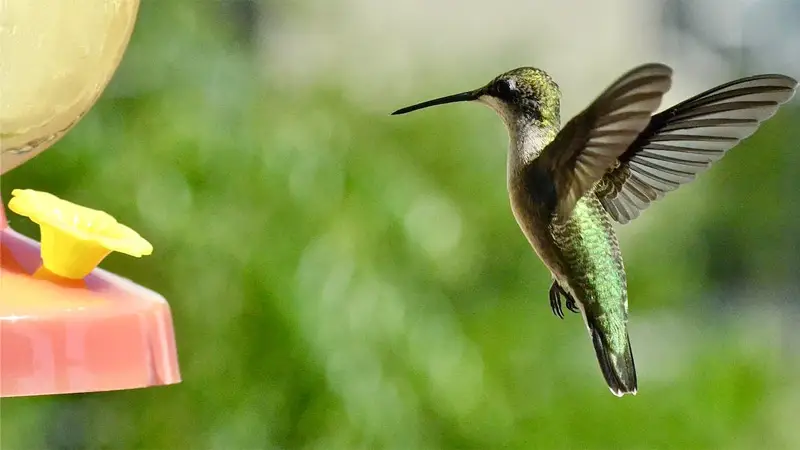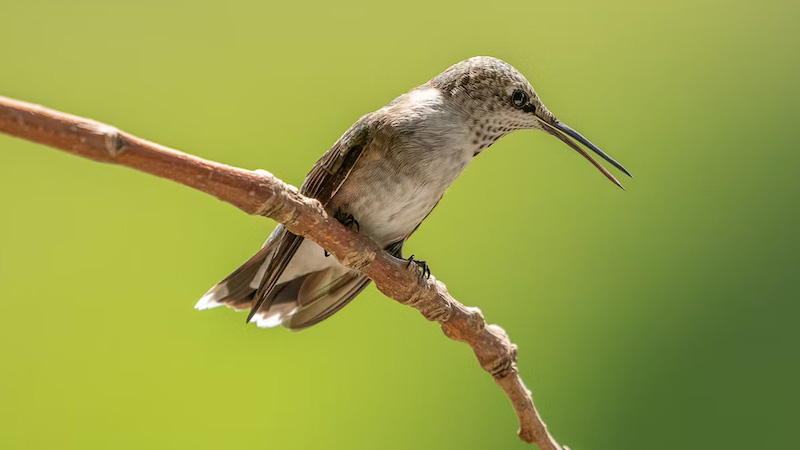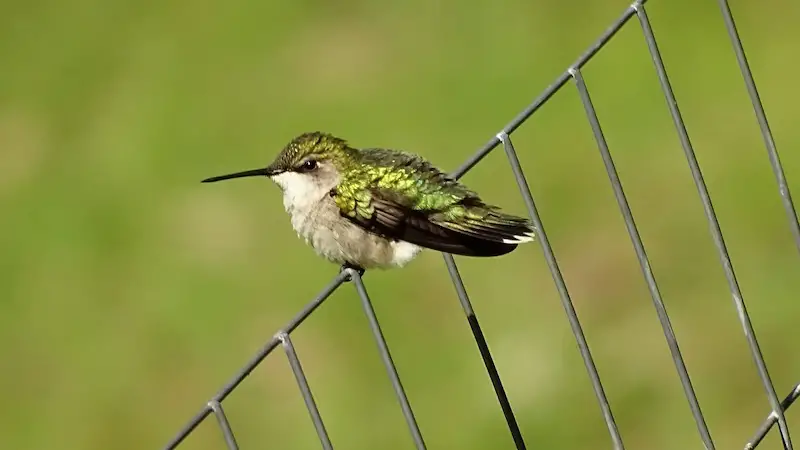Hummingbirds, with their vibrant colors and mesmerizing flight patterns, captivate our attention and curiosity. One intriguing aspect of these tiny creatures is the humming sound they produce.
Why do hummingbirds hum? The answer lies in the unique physiology and behaviour of these remarkable birds. From their rapid wing beats to their intricate courtship displays, there are fascinating reasons behind the humming sound emitted by hummingbirds.
Exploring the purpose behind their hum sheds light on their adaptations, communication methods, and the role it plays in their survival and social interactions.
In this article, we will delve into the captivating world of hummingbirds and uncover the secrets behind their humming behaviour.

Why Do Hummingbirds Hum?
Hummingbirds are known for their unique ability to hover and produce a distinct humming sound.
There are several reasons why hummingbirds hum, each contributing to their fascinating behaviour:
Wing Beat Frequency
Hummingbirds have an incredibly fast wing beat, which can range from 50 to 200 beats per second, depending on the species. This rapid movement creates vibrations in the air, resulting in the humming sound that is characteristic of these birds.
Aerodynamic Adaptations
The hummingbird’s wings are uniquely designed to generate lift and manoeuvrability. They have a specialized ball-and-socket joint at the shoulder, allowing them to rotate their wings in a figure-eight pattern.
This motion, combined with their rapid wing beats, helps them achieve sustained hovering, further contributing to the humming sound.
Courtship Displays

Male hummingbirds often engage in elaborate courtship displays to attract females. These displays include aerial acrobatics and flashy flight patterns accompanied by a humming sound.
The humming serves as an auditory signal to potential mates, indicating the male’s presence and fitness.
Territorial Defense
Hummingbirds are highly territorial and will fiercely defend their feeding and nesting areas from intruders. The humming sound can act as an aggressive warning to other hummingbirds, signalling their claim to a specific territory.
Communication
Hummingbirds may also use their humming sound as a means of communication within their species.
Different patterns and frequencies of the hum can convey various messages, including warnings, aggression, or mating signals.
It is important to note that the humming sound of hummingbirds is not produced by vocal cords, as they lack them. Instead, it is a byproduct of their unique wing structure and rapid wing beats.
The humming sound adds to the allure and charm of these incredible birds, making them a delight to observe in their natural habitats.
What Part of a Hummingbird Makes the Humming Sound?

The distinct humming sound produced by hummingbirds is not created by their vocal cords, as hummingbirds lack them.
Instead, the humming sound originates from several specific parts of their anatomy, each playing a role in generating the unique sound:
Wings
The primary source of the humming sound is the rapid beating of the hummingbird’s wings. Hummingbirds have incredibly fast wing beats, ranging from 50 to 200 beats per second, depending on the species.
These rapid movements create vibrations in the air, producing the characteristic hum that gives hummingbirds their name.
Feather Structure
The structure of hummingbird feathers also contributes to the humming sound. The specialized shape and arrangement of their flight feathers create a unique airflow pattern during wing beats.
This airflow, combined with the rapid wing beats, generates turbulence and additional vibrations, enhancing the humming sound.
Tail Feathers
The tail feathers of hummingbirds also play a role in creating the humming sound. The outer tail feathers have specially modified tips called “racket tips” or “spatulas.”
During the flight, these tips separate and rapidly oscillate, further adding to the vibrational dynamics that contribute to the humming sound.
Air Resonance
The humming sound is amplified by air resonance. When the rapid wing beats and feather vibrations interact with the surrounding air, they create a resonance effect, similar to how musical instruments produce sound.
This amplifies the humming sound, making it more audible.
Together, the combination of wing beats, feather structures, tail feather oscillations, and air resonance creates the distinct humming sound associated with hummingbirds.
It is a unique adaptation that not only adds to the charm of these remarkable birds but also serves important functions in communication, territorial defence, and courtship displays.
Do All Hummingbirds Sound the Same?

While all hummingbirds share the characteristic ability to produce a humming sound, there are variations in the specific sound produced among different species and individuals.
Here are some factors that contribute to the variations in hummingbird sounds:
Wing Beat Frequency
Different hummingbird species have varying wing beat frequencies, resulting in differences in the pitch and tone of the humming sound they produce.
Larger hummingbirds tend to have slower wing beats, which can result in a deeper and more resonant hum. Smaller hummingbird species with faster wing beats may produce higher-pitched and more rapid humming sounds.
Feather and Body Size
The size and structure of hummingbird feathers and bodies can also impact the sound they produce. Variations in feather shapes, stiffness, and arrangement can influence the airflow and vibrations during wing beats, leading to differences in the humming sound.
Additionally, the size and shape of their bodies can affect the resonance and amplification of the sound.
Individual Variation
Just like with human voices, individual hummingbirds within the same species can have subtle variations in their humming sounds. These differences can be influenced by factors such as age, sex, and individual anatomy.
Some individuals may have slightly deeper or higher-pitched hums compared to others.
Environmental Factors
The environment in which hummingbirds are found can also influence the perceived sound.
Background noises, such as wind, foliage rustling, or other bird calls, can mask or alter the humming sound, making it more challenging to distinguish specific variations among different hummingbird species.
Overall, while there are general similarities in the humming sound produced by hummingbirds, there are also subtle differences influenced by species, size, individual characteristics, and environmental factors.
These variations add to the uniqueness and diversity within the fascinating world of hummingbirds.
FAQ
Hummingbirds hum primarily because of their rapid wing beats, which create vibrations in the air. These vibrations produce the distinct humming sound that gives these birds their name.
Hummingbirds generate the humming sound through the combination of their rapid wing beats, feather structure, tail feather oscillations, and air resonance. These factors contribute to the vibrations and turbulence that produce the humming sound.
No, different hummingbird species and individuals can produce variations in their humming sounds. Factors such as wing beat frequency, feather and body size, and individual variations contribute to differences in pitch, tone, and intensity among hummingbird species.
The humming sound serves various purposes for hummingbirds. It can be part of courtship displays to attract mates, a territorial defence mechanism to communicate boundaries, and a way to communicate with other hummingbirds within their species.
Yes, humans can hear the humming sound of hummingbirds. While the sound is at a higher frequency than what humans typically hear, it is audible and adds to the charm and uniqueness of these remarkable birds.
Conclusion
The humming sound produced by hummingbirds is a marvel of nature, offering us a glimpse into the intricacies of their behaviour and adaptations.
From their rapid wing beats that generate vibrations in the air to their elaborate courtship displays and territorial defence mechanisms, there are multiple reasons why hummingbirds hum.
It serves as a form of communication, a symbol of their agility, and a means to attract mates or establish dominance. The humming behaviour of these tiny avian wonders provides us with a deeper appreciation for their remarkable abilities and the intricate web of interactions that exist in the natural world.
As we listen to the delightful hum of a hummingbird, let us marvel at the fascinating reasons behind their melodious presence, reminding us of the diversity and beauty of life on our planet.